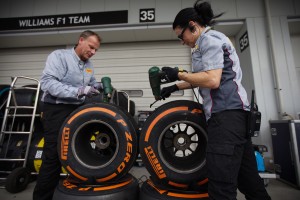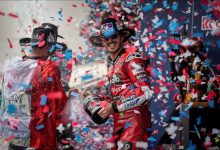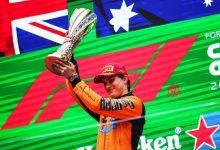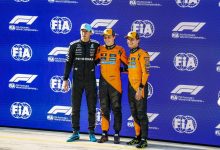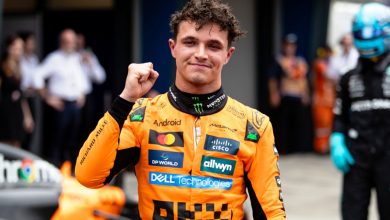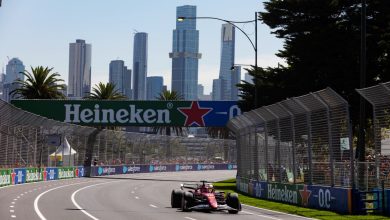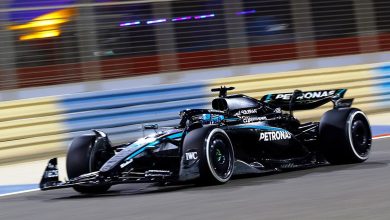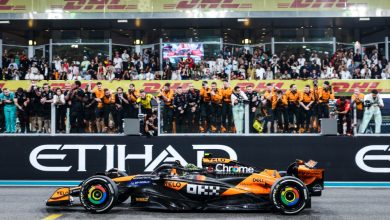There is no magic bullet; the Red Bull car development is the same: Newey
TEAM REPRESENTATIVES – Sam MICHAEL (McLaren), Rob WHITE (Renault Sport F1), Nick CHESTER (Lotus), Paddy LOWE (Mercedes), Adrian NEWEY (Red Bull Racing), James ALLISON (Ferrari)
PRESS CONFERENCE
Three of the gentlemen here are, of course, in new roles, one within the same team, in Nick’s case, but in Paddy and James within different teams, so plenty to talk about. James, can I start with you? How big is the job you’ve taken on at Ferrari and what’s it going to take to get back to winning ways?
James ALLISON: I think technical director at any Formula One team is a very big job, it certainly doesn’t leave room for much else than the job in your life, Ferrari is an extremely prestigious Formula One team with a lot of resource and an extremely high level of expectation. There is really no result other than winning that is good enough at Ferrari. So there is a lot of pressure to make sure I play my part in achieving that, but it is a wholly realistic ambition. It’s a team with the kit, with the resource, with the people and with the drivers to get the job done, so looking forward to being there when it happens.
You’ve been in the post for a few months now, what’s your assessment of what you’ve seen so far? Have you seen where changes need to be made and have you already started making those changes?
JA: I’ve, first of all, been very fortunate to arrive at Ferrari at a point in their cycle when a lot of the changes necessary to return to the front rank – I mean right at the front rank, i.e. winning championships – a lot of the changes necessary to do that have been put in place by Pat Fry. I think I’m particularly lucky to have arrived and been able to benefit from those investments rather than having to start them from scratch. There is much more to be done but I’m a lucky chap to be picking up where I am.
Thanks for the moment. Coming to you Nick. Obviously we have to start with Heikki Kovalainen and his performance this afternoon – fifth fastest in the free practice session. Was that as impressive within the team as it looked from the outside?
Nick CHESTER: Yes, it was. We feel he’s done a brilliant job today, particularly with all the procedures and getting used to driving a new car. We felt it might take a little bit of time. But actually straight away in P1 he was already looking after the car very well and in P2 he was fifth quickest and good long runs, I think he’s done a great job today.
Like James, you’ve been in your role for a little bit of time now, taking over from James at the Lotus team. What’s your route forward? Are you going to continue the path he had set or have you got some changes you want to make in the technical structure?
NC: There are a few changes. There are a couple of areas where we felt things could be moved on. Those are going into place now. Most of it’s a good baseline. It’s a very good team and there are a lot of good guys there. But there are always chances to look at things you could do better and you have to move those things on when you can.
Thank you for that. Paddy, coming to you. Like these other two gentlemen, you’re a few months into your position at Mercedes. What excites you about the role you have and how do you see it evolving over the next period of time?
Paddy LOWE: It’s fantastic to come to a team like Mercedes, they’ve got a very positive momentum. We’ve seen the progress made since last year through to this season. So it’s just fantastic to come into that team. Had a great welcome from Ross and all the other people there. It’s just very exciting to build on that. I really feel I can make a difference, but they’re already in a great place, with momentum going the same way.
Obviously, you’re locked in a fight for second place in the Constructors’ Championship with James’ team and Nick’s team. You’ve got it at the moment. If you were to finish there on Sunday in Sao Paulo – second in the championship – would you consider that a success for Mercedes this year, particularly given the distance behind Red Bull. And also, would it build a sense of expectation within the Mercedes board in terms of 2014?
PL: Absolutely. Formula One is a very tough business and you can’t build to championships from nowhere. Our target this year was actually to come third, so if we can get third or exceed third that would be meeting our ambitions. We very much hope we can get second and that would be a fantastic platform from which to mount an attack for the championship next year. But we have tough rivals around us, so we’re not underestimating how difficult that would be.
And expectations from the board if you were to do that [finish second]? Would that be a positive thing or would that put extra pressure on you?
PL: We get tremendous support from the board. Daimler is a very big company, with a huge, long pedigree of motor racing success. They’re full of support for us but they want us to win, clearly, and that what we want to do.
Coming to you Sam. Obviously we have to start by talking about the decision this week to replace Sergio Perez with Kevin Magnussen. Simple question: why was this the right thing to do?
Sam MICHAEL: I think it doesn’t overshadow the fact that we haven’t had a good enough car this year, I think that’s been pretty well documented, so it’s one of those decisions that every team takes every year. You look and assess where your capabilities are where you think you can improve and the view internally is that we could improve by going with Magnussen. As I said, Checo’s doing a fantastic job at the moment considering the pressure that he’s under. He’s keeping his head level and being very professional about it. So, very commendable his approach over the recent races, and as recently as this one. It’s obviously a discussion that’s been going on for quiet some time. It’s always going to be difficult when you make a call like that. But I think we’re in a very fortunate position at the moment with our young driver programme, in that it’s very rich with talent and Kevin’s just the first of the guys in that pool. I’ve come across lots of drivers in my time in Formula One and when you see drivers like that come along, it’s very important that you react and make the most of those opportunities. So really, it’s always a twofold thing. It’s what you currently have and what you can do to improve yourself. To be honest, it’s not that much different with engineers and designers and all your people. You’re always looking to add and improve the team. Clearly, the driver is much more in the public eye, because there’s only two of them and they’re in the race cars at any one time. Anyway, it’s a decision the team has taken and we’re looking forward from here.
Q: Jenson Button was saying yesterday that there’s a lot of work to do with the new technology for 2014 with these cars and obviously it’s an extra challenge having a rookie driving one of the two cars. To what extent have you factored that into your plans and is there an element of risk there?
SM: I think we’ve factored all of those sort of things into what we’re doing, including the testing he’s done for us already, all the simulator work, his performance in the lower categories and any sort of work that we can do between now and the start of next season. I think with the rule change – and it is a huge rule change, on the powertrain and aerodynamics – the way you drive the cars is going to be quite different. We’ve already done quite a lot of work in the simulator on that at this point and, if anything, it probably lends itself some good opportunities for change. To be honest you can argue that either way: you can argue and say experience is going to count; you can also argue the benchmark is being reset. But ultimately it’s four tyres on the ground that you drive as quick as you can around a circuit. We’ve got a good balance of Jenson, who’s a world champion, plenty of experience, and if you’re going to have the risk that you take of putting a young guy in – because there inevitably is – then it’s a good time to do it.
Q: Adrian, obviously the standout story of this season is the way that you have developed this Red Bull car and also, Sebastian’s way of driving it. Now that the title is decided and obviously the technology is obsolete for next year, can you tell us how you did it?
Adrian NEWEY: There’s no magic bullet, it’s the usual development story I think. This year’s car was a very close cousin of last year’s. Relatively small evolutions over the winter with essentially stable regulations. So really started this year where we left off last year from a car point of view and it was just about developing it, understanding it. I think the change in tyres back to the 2012 tyres was also obviously something that had an effect on the car and possibly suited us – it’s difficult to know exactly. So general development, no magic.
Q: Obviously continuity is an important part of your success, as it was with Ferrari’s ten years ago. You’re losing one of your closest lieutenants in Peter Prodromou who’s moving on at some point in the next couple of years. What’s your feeling on that? How disappointed are you in that and how difficult is it to keep a winning group together?
AN: Movement is the nature of Formula One – and you only have to look at the people sitting at this table. I think it’s healthy in many ways that there is a bit of movement otherwise it would all go stale. I am sad that Peter’s leaving because I’ve worked with him for many years but I guess he has his reasons for wanting to move on. I think we’ve got good strength in depth in Red Bull so we will carry on as well.
Q: Rob, as Adrian was saying, there has been a fair bit of movement between teams of engineers and obviously the same thing’s been going on to some extent within engine builders as well. As a result of that do you feel you have a better understanding now of where you stand relative to Mercedes and Ferrari in terms of 2014 technology – and where do you think that is?
Rob WHITE: I think the first thing to say is that traditionally – and it’s still the case – there’s perhaps a less volatile environment amongst the engine people and that remains the case and there hasn’t been substantial movement around. Answering the question about does that give us incite into where we stand relative to the other guys in 2014, we have very little way of knowing where we shall be in 2014 relative to the others. At the moment, it’s absolutely about getting the best out of our own programme, making the best of the resources that we have. I feel that we have everything that we need to do a good job but we’re now in a phase where actually delivering is absolutely the top of everybody’s job list.
Q: And how much will driving styles have to change next year, do you think and how much slower or how much faster will the cars be do you believe than they are this year?
RW: I think driving style… I’m not sure I can give a good answer to that but one of the things that I think will be important and perhaps a differentiating factor is just the capacity to get the most out of these new and complex power units and the way in which they’ll be operated over the course of the race weekend. Clearly we’ve had some idea of what this would entail for some long time but we’re getting up close and personal now with the necessary tools and procedures necessary to do that. Some of the underlying engineering work is still under way. Some of the code-writing in order to execute the necessary control systems on the cars is still under way and the tools that the engineers and technicians in the garage will use to look after it all is still work in progress. I think the drivers adapting to the new environment will be something that will be interesting to watch.
QUESTIONS FROM THE FLOOR
Q: (Dan Knutson – Auto Action and National Speedsport News) For the five chassis guys, how do you see next season unfolding and what is the target for your team?
NC: Our target is to carry on where we’ve been now, so try and be around the top three in the constructors. It’s a bit hard to say how it’s going to develop right from this point. The changes are so big, it’s the biggest change in regulations that I’ve seen in 20 years in the sport and there’s going to be a lot of different solutions. It will be very interesting to see what everyone takes to the first race. There will be different solutions for aerodynamics and some cars will be better packaged than others.
SM: I think that Nick’s right about the magnitude of change. I think it’s going to be a development war all the way through the season and probably into the next year as well, it’s such a big change to not just the powertrain but the aerodynamics and knowing that the slope that we currently have in the wind tunnel… when you have a slope so steep, then it normally means that you’re far away from the optimum when you first make these type of changes. The powertrain is probably bigger in reality and probably more visible because you have such a brand new gearbox, brand new engine, completely new ERS system and don’t underestimate how developed these current powertrains are on all fronts because they’ve been… especially the engine, obviously, but also the gearbox so those changes are significant as well. I’m sure you will see different levels of reliability, even though teams are much better now than what they used to be 10/15 years ago with dynos and simulations etc, there’s nothing that has anywhere near… you can’t replicate the almost decade of powertrain mileage on the track across different teams so I think that’s going to be a big player in the next year and potentially a bit longer.
Q: (Dan Knutson – Auto Action and National Speedsport News) And the team’s target?
SM: To win.
JA: Ferrari’s target is always to win. As far as how next year will work out, I think that the size of the rule change means that there will be some unanticipated reshuffling of the pack in terms of where all the teams will find themselves in the pecking order. However, I think – notwithstanding the size of the changes – over the years it’s been fairly clear that the teams, although they’re hundreds of people in different places end up producing cars independent of one another that come together and are very competitive with one another and I would expect that to be true next year as well. I would also imagine that the first half of next year is likely to be heavily affected by reliability. Next year’s rule changes are big enough, just in terms of the configuration of the car but they also place a much much higher burden of reliability on us as well.
Q: Adrian, Mark Webber was saying that he sees Red Bull as the clear favourites for next year. Do you see it that way?
AN: Don’t know to be perfectly honest. I think that first of all, as James said, the cars are hugely complex compared to the cars that we’ve been used to. The level of reliability that everybody’s achieving now is the result of a lot of evolution on what actually looks a relatively simple product compared to what we’re facing next year so I think reliability’s going to be quite an issue for the teams, could well be a deciding factor in the championship, who knows? And then, as everybody’s said, then effectively you can divide it into the very large powertrain regulation changes which is obviously in the powertrain itself down to the three manufacturers for next year, but then from the team’s point of view, how you install the engines and the power train… I’m sure there’s going to be a lot of different solutions to start with to what is a very complicated problem.
PL: Our target is to win and I think the exciting aspect about next year is that we return to competition amongst engines. The last seven or eight years, the engine has been a frozen product. Of course there are differences between the engines but not in the way they used to be, so we return to an issue of a campaign not just with the chassis but with the power unit as well and I think that’s really exciting and a good thing for Formula One.
Q: (Ian Parkes – Press Association) James, having worked with Kimi for a while at Lotus, how important do you feel your familiar face will be to him at the start of next season to ensure that he hits the ground running?
JA: I don’t think it will make much difference to Kimi at all! Beautiful though I am, I don’t think I have a massive impact on his life. Kimi’s relationship with the team is predominantly with the people that are at the track, racing the car, with him, with his race engineer and with the chief race engineer and the people that campaign round the world with him. My job is mainly a factory-based one and while I would try to lead a factory team that is sensitive to what the drivers are saying about the car and hopefully making the most of the feedback that they give us, my day-to-day interaction with the drivers is not overly extensive.
Q: (Karen Crouse – New York Times) Adrian, what are the one or two qualities Sebastian possesses that you think separates him from all the other drivers right now?
AN: Crikey. I think he, like all the true greats, then he has the ability to drive the car and at the same time have enough mental reserve to be able to understand how he’s driving the car and be able to play that back and understand when to push and when not to, how the race is unfolding. I think he has very good recall which means that when he gets out of the car he’s able to play back in his own mind what he’s experienced, digest that. He works hard in the evenings with the race engineers and the result of all that is that when he steps in the car again the next day he’s learned that little bit more. You apply that over many races then he keeps improving.
Q: (Edd Straw – Autosport) Question for the three in the front row: obviously, from a performance point of view the answer is not at all, but how important is it that Formula One cars look really good, look spectacular and therefore how important is it that the regulations that dictate what the cars look like are conceived with that in mind?
PL: Yes, it’s an interesting question. I think, in the end, cars tend to look good when they’re quick, so we take a while to get used to change but it’s surprising how you look back at old cars and they suddenly don’t look so attractive when you didn’t like the change that came. But I think any car that actually is quick tends to start looking good, that’s my view.
Q: James, do you agree with that?
JA: Yeah. I think if you look back over the years there are some prettier years than other years. When 2009 came along, I didn’t like the look of those cars at all but I’m wholly used to it now and I think they look pretty sexy. The stepped nose… again, I didn’t like that to start with but I’m OK with it now. So I think as a technical team, we really have a duty to try and make the thing quick rather than make it beautiful. Hopefully the beauty is got for free along the way.
Q: Adrian, are aesthetics important to you when you put a car together?
AN: They are important but they are kind of dictated by the rules inasmuch as technically obviously our job is to try and make the car as quick as possible rather than to win any styling awards so we are at the mercy of the regulations in that regard. I must admit that I think the regulations have caused some ugly areas… in terms of the stepped nose I think aren’t as attractive as they used to be. Probably, in truth, the narrow track cars I don’t think have ever looked quite as attractive as… they’ve always looked a bit out of proportion compared to the pre-’98 cars. The low nose that we have next year, I think there could be some fairly awkward looking aesthetics, nose arising. So it’s something that in my view should be given a bit more consideration when the regulations are drawn up.
Q: (Craig Scarborough – Scarbs F1) You’ve all spoken – looking towards next year – about unreliability being a big issue; with winter testing being quite a limited amount of time… you can obviously spend a lot of time with red flags with your cars in the garage, how’s that going to affect your winter testing approach, and equally, is there a case for two car test teams now?
NC: Well obviously it puts a lot impetus to make sure we get to the first test with a car that can run as much as possible, so that means you put a lot more effort into the dyno work and you try and get there with something that’s going to get you out on track as much as possible but I think everyone’s expecting they’re going to find a few problems. I think the development through the first three tests and up to the first race will be very very strong.
RW: In real life, the opportunity to substantially change the specification as a result of what happens in testing independent of the timing, give or take a week or two, is quite limited but it’s absolutely a key part of the final phase of preparation to go racing. Yeah, reliability is a tough call. We have to aim for the same place, which is of course not to break down, not to stop the car. It’s more difficult to achieve because the systems are more complicated, more numerate on the car. It’s more difficult to achieve because the durability requirement is higher. Coming back to the question: how would it affect the way we approach testing, I think paradoxically then we have a responsibility to be more ready and to be aiming to role-play the race weekend right from the very start of private testing. I’m sure that there’s so much new stuff to come in all of the procedures in every stage of the weekend that we’ll going to be trying to practise those right from the get-go.
SM: I think it’s the same as what those guys said, it’s going to be pretty tight in that time. If you have major problems they are difficult to solve, not impossible, that’s what F1 teams are quite capable of proving, impossible things are possible in that short period of time as with all the experience round here. So I think it’s an entirely necessary area. If you get into fundamental redesign such as bearing issues or cooling problems, they can be quite damaging but I don’t think it really changes… I think in terms of… one of your questions was about two car testing, I think one of the reasons for going with a single car was cost and containment. I think in terms of parts and things like that, it would be a pretty tall order to go and produce two cars at this stage of the day.
Q: (Ian Parkes – Press Association) Paddy, we’ve had a lot of speculation about Ross’s position over the past month or so. Are you able to shed any more light on that, going forward, your prospects of taking over as team principal? Is it being mentioned at all in any meetings with Daimler etc?
PL: There’s been a lot of talk about this in the last few months, you’re right. The fact is that Ross will step back at some point. It’s not clear what the timing is for that or whether he will step back completely or remain in a different role within the team. At the moment we’re waiting for Ross’s call on that. In the meantime, I’m working very well with Ross and with Toto, there’s no issue there, we work very well together. I would like to say there’s no impatience on that aspect, so we’ll just have to wait and see how it turns out.
Ends
